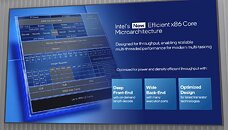Thursday, August 19th 2021

Intel's Secret Sauce at Catching Up with AMD Core Count is the Gracemont E-core and its Mind-boggling Perf/Watt
When early benchmarks of the Core i9-12900K "Alder Lake-S" processor showing performance comparable to AMD's top 16-core Ryzen 9 5950X surfaced, we knew something was up. 8 Intel P-cores and 8 E-cores, are able to match 16 "Zen 3" cores that are all performance cores. Apparently Intel is able to turn its P-core deficit around by taking a wacky approach. First, the 8 "Golden Cove" P-cores themselves offer significantly higher IPC than "Zen 3." Second, the 8 "Gracemont" E-cores aren't as "slow" as conventional wisdom would suggest.
Intel in its Architecture Day presentation put out some astounding numbers that help support how 8 big + 8 little cores are able to perform in the league of 16 AMD big cores. Apparently, on "Alder Lake-S," the 8 "Gracemont" E-cores enjoy a lavish power budget, and are able to strike an incredible performance/Watt sweet-spot. Intel claims that the "Gracemont" E-core offers 40% higher performance at ISO power than a "Skylake" core (Intel's workhorse P-core for desktops until as recently as 2020); which means it consumes 40% less power at comparable performance.A "Gracemont" core hence doesn't end up too far behind "Skylake." The combination of high-IPC P-cores and "fairly fast" E-cores are hence able to attain performance levels comparable to 16 "Zen 3" cores. There are some limitations, though. For starters, "Gracemont" cores don't support HyperThreading, unlike "Skylake," and have a reduced ISA instruction-set compared to the P-cores.
Intel in its Architecture Day presentation put out some astounding numbers that help support how 8 big + 8 little cores are able to perform in the league of 16 AMD big cores. Apparently, on "Alder Lake-S," the 8 "Gracemont" E-cores enjoy a lavish power budget, and are able to strike an incredible performance/Watt sweet-spot. Intel claims that the "Gracemont" E-core offers 40% higher performance at ISO power than a "Skylake" core (Intel's workhorse P-core for desktops until as recently as 2020); which means it consumes 40% less power at comparable performance.A "Gracemont" core hence doesn't end up too far behind "Skylake." The combination of high-IPC P-cores and "fairly fast" E-cores are hence able to attain performance levels comparable to 16 "Zen 3" cores. There are some limitations, though. For starters, "Gracemont" cores don't support HyperThreading, unlike "Skylake," and have a reduced ISA instruction-set compared to the P-cores.



49 Comments on Intel's Secret Sauce at Catching Up with AMD Core Count is the Gracemont E-core and its Mind-boggling Perf/Watt
Do I agree, no.
There have always been good cores that used less power and bad cores that needed a lot of power for the same frequency even after binning
Only option was to turn off hyper threading on all, not just the bad cores so this sounds like intel is doing this on bad cores saying they are now small cores
Only option users had prior was to lower frequency on the bad cores.
Some benchmarks disabling hyper threading actually increases scores just like it may help games perform better.
Over the last 20 year's we had, I used big and small cores, I didn't build a dislike for small, barely capable cores without effort.
They will suit some better than traditional CPU, but not me.
Also consider that they're competition manage to make multi core big core ccds without a graveyard of dead core's.
And little cores without HT are down 30% from the off then are smaller and less capable, more wouldn't equal more capability in most cases, and how much back end crap do people need running OS's, do still suspend useless processes you know.
What is the freaking point anyway?
There are gazillion of cores per CPU, don't need that much?
Lower clocks.
Still don't need that much?
Lower clocks further.
Not happy yet?
Shut down cores.
Why bother with the "little" bazingas?
If I want my code to run on little bazingas, why don't i buy CPU with 128 bazinga's in it instead?
Windows : what the hell is this CCX CCD, whatever just run high demand software on SMT, until they fixed scheduler...... Then intel making this big.LITTLE cpu, windows be like : ah shet here we go again
Nobody stated the finally frequency of both cores, just the IPC. And people are so confused about IPC that they think it means the total performance of a cores.
we will see.
I did assist with hardware for our new conditioning monitoring servers. Ten 960GB ssds in a Raid5 or something. They were not cheap lol
from the wiki
"
In April 2018, Keller joined Intel, where he served as Senior Vice President.[21][22][23] He resigned from Intel June 2020 officially citing personal reasons.[24] Though later it was reported that he left over a dispute on whether the company should outsource more of its production.[25]
Jim Keller joined Tenstorrent as CTO in December 2020.[26]"
It's not what gamers were hoping for. Not even the industry. But it is a step in the right direction again and the next generations will change a lot for all (gamers and "professional users" both).